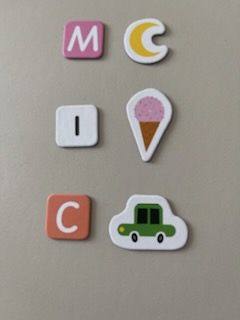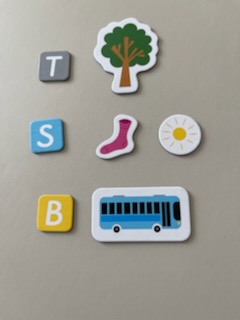Training in sound identification
Description
- Children may have difficulties in discriminating sounds in words.
- Discriminating initial sounds from words is usually easier than discriminating sounds in the middle or end of a word.
This is important for both reading and writing since one has to be able to segment words into speech sounds in order to write correctly and synthesize sounds in order to read correctly. When training sound identification it is more effective if the child can see the trained letters of the sound(s) at the same time.
Material
Any kind of appropriate writing surface such as a board or a book. Any kind of material the teacher may find useful for teaching e.g., pictures or objects in the classroom.
Rhyming
Rhyming Includes nursery rhymes, songs, poems and storybooks with patterned rhymes in your daily read-aloud program.
When reading a familiar poem or rhyme, pause before a rhyming word and let children fill in the rhyme.
Example:
One, two, three, four, five.
Once I caught a fish – (alive).
Six, seven, eight, nine, ten.
Then I let it go – (again).
Why did I let it go?
Because it bit my finger – (so).
Which finger did it bite?
The little finger on the – (right)
Create your own simple rhymes and invite children to try some as well.
Example: Here is a cat. The cat is wearing a – (hat).
When children are familiar with the concept of rhyme, they may match pictures that rhyme.

Initial sound training
Help children to identify the initial sounds of their names. Example: Pick one child and ask him or her to say his or her name (Mary). Write the name on the board. Help the child identify what the initial sound is in the name (/m/). Ask the children to mention other names in the classroom that start with the same sound.
Teach the easiest and most frequent letters first (usually vowels and the simple consonants (e.g., ‘S’ and ‘R’) before teaching the other consonants. Identify familiar objects that have the initial sound you want to teach. Then show the word. Point to the letter and tell the children how it sounds.
The teacher should stress the vowel or the consonant that he or she intends to teach.
Example: Point to an orange and ask the children to say what it is. The teacher says “Orange” Ask what sound the children hear first. Show the word “Orange”. Ask for other words that start with “O”.
Write a letter on the board. Ask how it sounds or what sound it represents. The teacher can give an example of a word that has the sound in the beginning and then ask children to identify
some words that have similar beginnings.
Example: Write the letter ‘A’ on the board; ask the children how it sounds. Give an example of the word apple, which starts with the sounds /a/, and then ask the children to give other words that start with a similar sound.
The teacher selects words that have similar beginnings and makes songs or sentences using these words. Then he or she encourages the children to think of other words that begin with
similar letters.
Example: Paul, picked, pieces of paper.

Sound identification
The teacher can say three (3) words, two of which have similar initial sounds. Ask the child to identify the one that has a different initial sound. Example: Say apple; ball; ant. Ask the child to tell you which of them is different (ball).
The teacher can have several letters on the board/table. He or she selects some words and writes part of the word on the board/ table leaving out one of the letters. The teacher then
pronounces one word at a time and asks the child to put the missing letter to the word.
Example: Write pa, girl, do. Show pa and say “pat” and ask the child which letter is missing. The child answers “t” and adds the missing letter to the word. Then show girl and say “girls” etc.